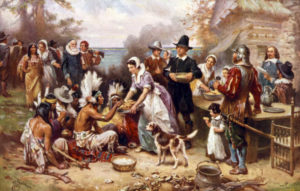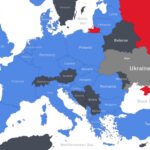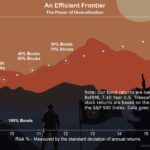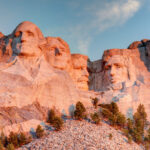
The first Thanksgiving, 1621, Pilgrims and natives gather to share a meal, oil painting by Jean Louis Gerome Ferris, 1932. By Everett Collection @ Shutterstock.com
The year 2021 marked the 400th anniversary of Thanksgiving.
The first Thanksgiving was William Bradford and Plymouth Colony thanking God for their blessings. That’s the first Thanksgiving.
Who Were the Pilgrims?
Well early in the 17th century, King James I was persecuting “anyone and everyone” who did not recognize The Church of England’s absolute civil and spiritual authority.
The first Pilgrims were Christian rebels, who, according to Rush Limbaugh, challenged King James’ ecclesiastical authority.
In England in the 1600s, those who believed strongly in freedom of worship were hunted down, imprisoned, and sometimes executed for their beliefs.
The story of the Pilgrims begins in the early part of the seventeenth century … The Church of England under King James I was persecuting anyone and everyone who did not recognize its absolute civil and spiritual authority.” The first Pilgrims were Christian rebels, folks. “Those who challenged [King James’] ecclesiastical authority and those who believed strongly in freedom of worship were hunted down, imprisoned, and sometimes executed for their beliefs” in England in the 1600s.
A group of separatists, (Christians who didn’t want to buy into the Church of England or live under the rule of King James), “first fled to Holland and established a community” of themselves there.
“After eleven years, about forty of them” having heard about this New World Christopher Columbus had discovered, decided to go. Forty of them “agreed to make a perilous journey to the New World, where [they knew] they would certainly face hardships, but” the reason they did it was so they “could live and worship God according to the dictates of their own consciences” and beliefs.
The Mayflower Compact
“On August 1, 1620, the Mayflower set sail. It carried a total of 102 passengers, including forty Pilgrims,” now known as Pilgrims, “led by William Bradford. On the journey, Bradford set up an agreement, a contract, that established” how they would live once they got there. The contract set forth “just and equal laws for all members of the new community, irrespective of their religious beliefs,” or political beliefs.
“Where did the revolutionary ideas expressed in the Mayflower Compact come from? From the Bible.
The Pilgrims were a “devoutly religious people completely steeped in the lessons of the Old and New Testaments. They looked to the ancient Israelites for their example. And, because of the biblical precedents set forth in Scripture, they never doubted that their experiment would work.” They believed in God. They believed they were in the hands of God. The journey” to the New World on the tiny, by today’s standards, sailing ship … was long, arduous.
A Cold, Barren, Desolate Wilderness
There was sickness, there was seasickness, it was wet. It was the opposite of anything you think of today as a cruise today on the open ocean. When they “landed in New England in November, they found, according to Bradford’s detailed journal, a cold, barren, desolate wilderness. There were no friends to greet them, he wrote. There were no houses to shelter them. There were no inns where they could refresh themselves.” There was nothing.
Incompetent Pilgrims
The sacrifice they had made for freedom was just beginning. During the first winter, half the Pilgrims — including Bradford’s own wife — died of either starvation, sickness or exposure.” They endured that first winter. “When spring finally came,” they had, by that time, met the indigenous people, the Indians, and indeed the “Indians taught the settlers how to plant corn, fish for cod and skin beavers” and other animals “for coats.” But there wasn’t any prosperity. “[T]hey did not yet prosper!” They were still dependent. They were still confused. They were still in a new place, essentially alone among likeminded people.
This is important to understand because this is where modern American history lessons often end. Thanksgiving is actually explained in some textbooks as a holiday for which the Pilgrims gave thanks to the Indians for saving their lives, rather than what it really was. That happened, don’t misunderstand. That all happened, but that’s not — according to William Bradford’s journal — what they ultimately gave thanks for. “Here is the part that has been omitted: The original contract” that they made on the Mayflower as they were traveling to the New World…
They actually had to enter into that contract “with their merchant-sponsors in London,” because they had no money on their own. The needed sponsor. They found merchants in London to sponsor them. The merchants in London were making an investment, and as such, the Pilgrims agreed that “everything they produced to go into a common store,” or bank, common account, “and each member of the community was entitled to one common share” in this bank. Out of this, the merchants would be repaid until they were paid off.
All of the land they cleared and the houses they built belong to the community as well.” Everything belonged to everybody, and everybody had one share in it. They were going to distribute it equally.” That was considered to be the epitome of fairness, sharing the hardship burdens and everything like that. “Nobody owned anything. It was a commune, folks. It was the forerunner to the communes we saw in the ’60s and ’70s out in California,” and other parts of the country.“ It, by the way, was complete with organic vegetables.
“Bradford, who had become the new governor of the colony, recognized that” it wasn’t working. It “was as costly and destructive…” His own journals chronicle the reasons it didn’t work. “Bradford assigned a plot of land” to fix this “to each family to work and manage,” as their own. He got rid of the whole commune structure and “assigned a plot of land to each family to work and manage,” and whatever they made, however much they made, was theirs. They could sell it, they could share it, they could keep it, whatever they wanted to do.
What really happened is they “turned loose” the power of a free market after enduring months and months of hardship — first on the Mayflower and then getting settled and then the failure of the common account from which everybody got the same share. There was no incentive for anybody to do anything. And as is human nature, some of the Pilgrims were a bunch of lazy twerps, and others busted their rear ends. But it didn’t matter because even the people that weren’t very industrious got the same as everyone else. Bradford wrote about how this just wasn’t working.
Lessons Learned
What did Bradford and his community find? According to Bradford’s diary, “was that the most creative and industrious people had no incentive to work any harder than anyone else…
“[W]hile most of the rest of the world has been experimenting with socialism for well over a hundred years — trying to refine it, perfect it, and re-invent it — the Pilgrims under Bradford decided early on, to scrap it permanently,” because it brought out the worst in human nature, it emphasized laziness, it created resentment, continues Rush.
Bradford and his community unharnessed the power of good old free enterprise by invoking the undergirding capitalistic principle of private property. Every family was assigned its own plot of land to work and permitted to market its own crops and products.
What was the result? According to Bradford’s diary, “This had very good success, for it made all hands [everybody] industrious, so as much more corn was planted than otherwise would have been.’ …
The Original Supply Side Economics
In no time, the Pilgrims found they had more food than they could eat themselves. Now, this is where it gets really good, folks, if you’re laboring under the misconception that I was, as I was taught in school. So they set up trading posts and exchanged goods with the Indians. The profits allowed them to pay off their debts to the merchants in London.
“And the success and prosperity of the Plymouth settlement attracted more Europeans and began what came to be known as the ‘Great Puritan Migration.’” The word of the success of the free enterprise Plymouth Colony spread like wildfire and that began the great migration. Everybody wanted a part of it. There was no mass slaughtering of the Indians. There was no wiping out of the indigenous people, and eventually — in William Bradford’s own journal — unleashing the industriousness of all hands ended up producing more than they could ever need themselves.
The Pilgrims’ prosperity led to their selling or exchanging the fruits of their labor with the Indians, who in turn were very helpful, continues Rush.
Puritan kids had relationships with the children of the Native Americans that they found. This killing the indigenous people stuff, they’re talking about much, much, much, much later. It has nothing to do with the first thanksgiving.
From Plimoth Plantation:
According to Tom Begley, executive liaison for administration, research, and special projects at Plimoth Plantation:
Basically (Thanksgiving) was to celebrate the end of a successful harvest,
The three-day celebration included feasting, games and military exercises, and there was definitely an amount of diplomacy between the colonists and the native attendees as well.”




